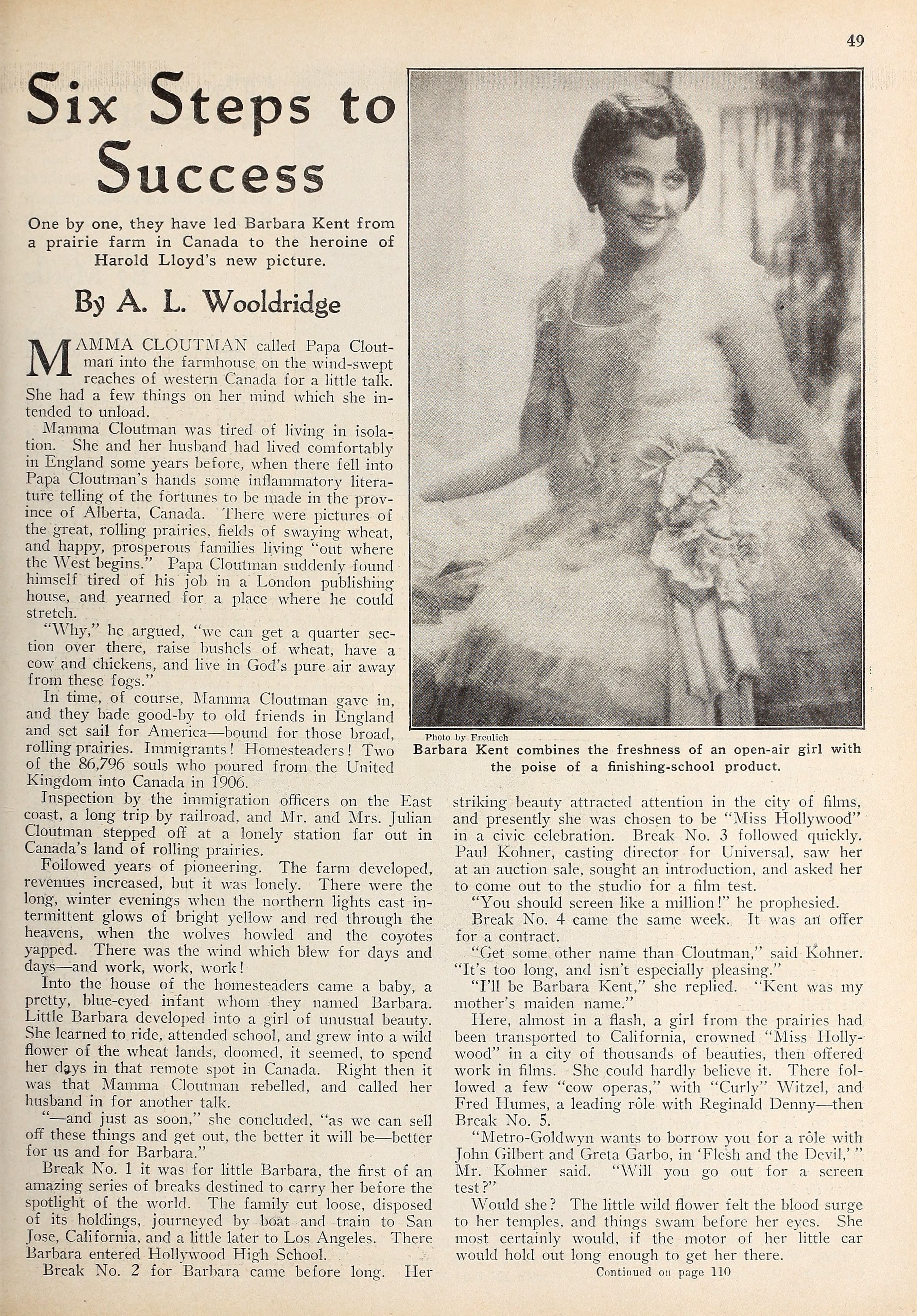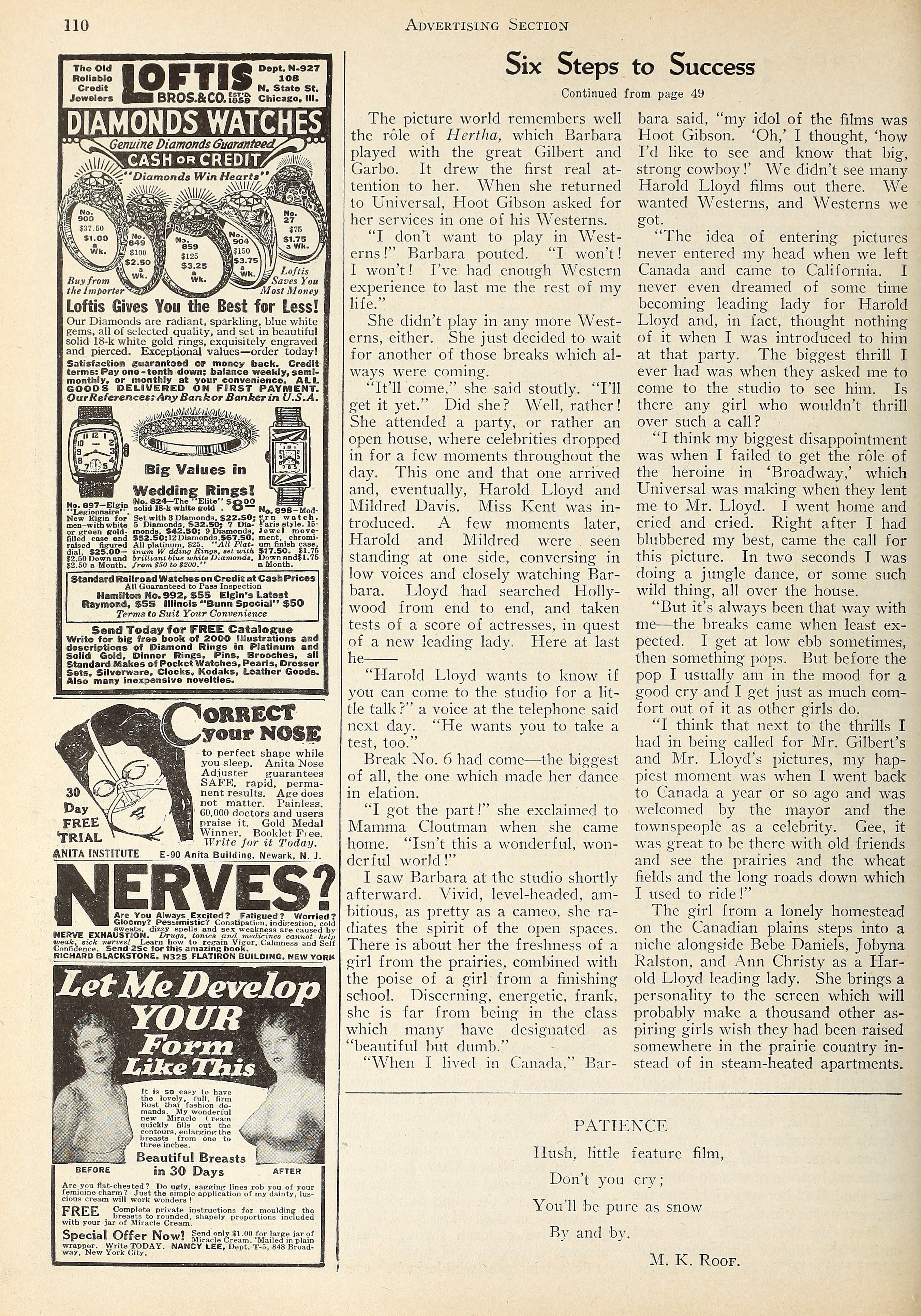Barbara Kent — Six Steps to Success (1929) 🇺🇸

Mamma Cloutman called Papa Cloutman into the farmhouse on the wind-swept reaches of western Canada for a little talk. She had a few things on her mind which she intended to unload.
by A. L. Wooldridge
Mamma Cloutman was tired of living in isolation. She and her husband had lived comfortably in England some years before, when there fell into Papa Cloutman’s hands some inflammatory literature telling of the fortunes to be made in the province of Alberta, Canada. There were pictures of the great, rolling prairies, fields of swaying wheat, and happy, prosperous families living “out where the West begins.” Papa Cloutman suddenly found himself tired of his job in a London publishing house, and yearned for a place where he could stretch.
“Why,” he argued, “we can get a quarter section over there, raise bushels of wheat, have a cow and chickens, and live in God’s pure air away from these fogs.”
In time, of course, Mamma Cloutman gave in, and they bade good-by to old friends in England and set sail for America — bound for those broad, rolling prairies. Immigrants! Homesteaders! Two of the 86,796 souls who poured from the United Kingdom into Canada in 1906.
Inspection by the immigration officers on the East coast, a long trip by railroad, and Mr. and Mrs. Julian Cloutman stepped off at a lonely station far out in Canada’s land of rolling prairies.
Followed years of pioneering. The farm developed, revenues increased, but it was lonely. There were the long, winter evenings when the northern lights cast intermittent glows of bright yellow and red through the heavens, when the wolves howled and the coyotes yapped. There was the wind which blew for days and days — and work, work, work!
Into the house of the homesteaders came a baby, a pretty, blue-eyed infant whom they named Barbara. Little Barbara developed into a girl of unusual beauty. She learned to ride, attended school, and grew into a wild flower of the wheat lands, doomed, it seemed, to spend her days in that remote spot in Canada. Right then it was that Mamma Cloutman rebelled, and called her husband in for another talk.
“— and just as soon,” she concluded, “as we can sell off these things and get out, the better it will be — better for us and for Barbara.”
Break No. 1 it was for little Barbara, the first of an amazing series of breaks destined to carry her before the spotlight of the world. The family cut loose, disposed of its holdings, journeyed by boat and train to San Jose, California, and a little later to Los Angeles. There Barbara entered Hollywood High School.
Break No. 2 for Barbara came before lone. Her striking beauty attracted attention in the city of films, and presently she was chosen to be “Miss Hollywood” in a civic celebration.
Break No. 3 followed quickly. Paul Kohner, casting director for Universal, saw her at an auction sale, sought an introduction, and asked her to come out to the studio for a film test.
“You should screen like a million!” he prophesied.
Break No. 4 came the same week. It was an offer for a contract.
“Get some other name than Cloutman,” said Kohner. “It’s too long, and isn’t especially pleasing.”
“I’ll be Barbara Kent,” she replied. “Kent was my mother’s maiden name.”
Here, almost in a flash, a girl from the prairies had been transported to California, crowned “Miss Hollywood” in a city of thousands of beauties, then offered work in films. She could hardly believe it. There followed a few “cow operas,” with “Curly” Witzel, and Fred Humes, a leading role with Reginald Denny — then Break No. 5.
“Metro-Goldwyn wants to borrow you for a role with John Gilbert and Greta Garbo, in Flesh and the Devil, Mr. Kohner said. “Will you go out for a screen test?”
Would she? The little wild flower felt the blood surge to her temples, and things swam before her eyes. She most certainly would, if the motor of her little car would hold out long enough to get her there.
The picture world remembers well the role of Hertha, which Barbara played with the great Gilbert and Garbo. It drew the first real attention to her. When she returned to Universal, Hoot Gibson asked for her services in one of his Westerns.
“I don’t want to play in Westerns!” Barbara pouted. “I won’t! I won’t! I’ve had enough Western experience to last me the rest of my life.”
She didn’t play in any more Westerns, either. She just decided to wait for another of those breaks which always were coming.
“It’ll come,” she said stoutly. “I’ll get it yet.” Did she? Well, rather! She attended a party, or rather an open house, where celebrities dropped in for a few moments throughout the day. This one and that one arrived and, eventually, Harold Lloyd and Mildred Davis. Miss Kent was introduced. A few moments later, Harold and Mildred were seen standing at one side, conversing in low voices and closely watching Barbara. Lloyd had searched Hollywood from end to end, and taken tests of a score of actresses, in quest of a new leading: lady. Here at last he
“Harold Lloyd wants to know if you can come to the studio for a little talk?” a voice at the telephone said next day. “He wants you to take a test, too.”
Break No. 6 had come — the biggest of all, the one which made her dance in elation.
“I got the part!” she exclaimed to Mamma Cloutman when she came home. “Isn’t this a wonderful, wonderful world!”
I saw Barbara at the studio shortly afterward. Vivid, level-headed, ambitious, as pretty as a cameo, she radiates the spirit of the open spaces. There is about her the freshness of a girl from the prairies, combined with the poise of a girl from a finishing school. Discerning, energetic, frank, she is far from being in the class which many have designated as “beautiful but dumb.”
“When I lived in Canada,” Barbara said, “my idol of the films was Hoot Gibson. ‘Oh,’ I thought, ‘how I’d like to see and know that big, strong cowboy!’ We didn’t see many Harold Lloyd films out there. We wanted Westerns, and Westerns we got.
“The idea of entering pictures never entered my head when we left Canada and came to California. I never even dreamed of some time becoming leading lady for Harold Lloyd and, in fact, thought nothing of it when I was introduced to him at that party. The biggest thrill I ever had was when they asked me to come to the studio to see him. Is there any girl who wouldn’t thrill over such a call?
“I think my biggest disappointment was when I failed to get the role of the heroine in ‘Broadway,’ which Universal was making when they lent me to Mr. Lloyd. I went home and cried and cried. Right after I had blubbered my best, came the call for this picture. In two seconds I was doing a jungle dance, or some such wild thing, all over the house.
“But it’s always been that way with me — the breaks came when least expected. I get at low ebb sometimes, then something pops. But before the pop I usually am in the mood for a good cry and I get just as much comfort out of it as other girls do.
“I think that next to the thrills I had in being called for Mr. Gilbert’s and Mr. Lloyd’s pictures, my happiest moment was when I went back to Canada a year or so ago and was welcomed by the mayor and the townspeople as a celebrity. Gee, it was great to be there with old friends and see the prairies and the wheat fields and the long roads down which I used to ride!”
The girl from a lonely homestead on the Canadian plains steps into a niche alongside Bebe Daniels, Jobyna Ralston, and Ann Christy as a Harold Lloyd leading lady. She brings a personality to the screen which will probably make a thousand other aspiring girls wish they had been raised somewhere in the prairie country instead of in steam-heated apartments.

Barbara Kent combines the freshness of an open-air girl with the poise of a finishing-school product.
Photo by: Roman Freulich (1898–1974)

Collection: Picture Play Magazine, May 1929
